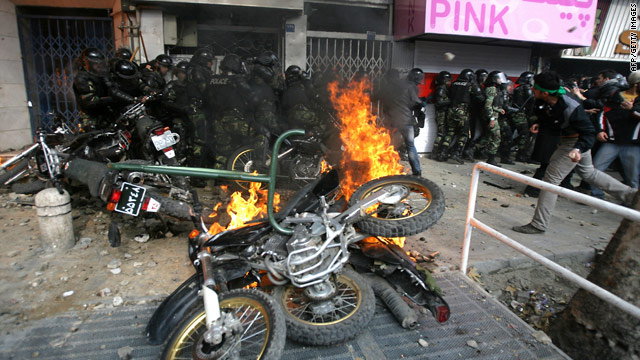DUBAI, United Arab Emirates – A huge funeral procession for Iran's most senior dissident cleric became a show of defiance against the country's rulers Monday as mourners flashed green protest colors and chanted against the Islamic leadership in Iran's holy city of Qom.
The response by authorities was not as punishing as in recent demonstrations — an apparent attempt to avoid bloodshed and chaos during the cortege for one of the patriarchs of the 1979 Islamic Revolution and the one-time heir to lead the country.
But the major outpouring for Grand Ayatollah Hossein Ali Montazeri by opposition supporters could signal a restive week ahead. Tens of thousands of demonstrators, if not more, filled the main boulevards in Qom, the hub of Islamic scholarship and study in mostly Shiite Iran.
Iran is marking one of the most important periods on the Shiite religious calendar with ceremonies that draw deeply on themes of martyrdom and sacrifice, which could inspire fresh opposition marches. It culminates on Sunday, the same day mourners will gather for the traditional seven-day memorial for Montazeri's death.
Opposition leaders have used holidays and other symbolic days in recent months for anti-government rallies. Montazeri, who died of apparent natural causes on Sunday at age 87, had stunned even hard-core protesters with his scathing denunciations of the ruling clerics and their efforts to crush dissent after the disputed presidential election in June.
His open assault on the highest reaches of the Islamic system helped galvanize the opposition and shatter taboos about criticizing the pinnacle of power: Supreme Leader Ayatollah Ali Khamenei.
On Monday, demonstrators chanted the now-familiar "Death to the Dictator" that's become a catchall slogan against Iran's leadership, witnesses said. Some protesters shouted specific slurs against Khamenei, according to video clips posted on the Web.
The witnesses spoke on condition of anonymity because of fear of arrest and the authenticity of the Web video could not be independently verified. The accounts, however, were consistent with reports from a variety of sources.
Iranian authorities barred foreign media from covering the funeral in Qom, about 60 miles south of Tehran. Communications also appeared disrupted.
Internet in Iran was slow, and cellular telephone service was unreliable. The government has periodically restricted communications in an attempt to prevent protesters from organizing.
But people had been streaming toward Qom since word of Montazeri's death began to spread.Crowds were packed shoulder-to-shoulder for blocks following the truck carrying Montazeri's body. A single white turban sat atop the vehicle.
Video posted on the Web showed people beating their chests in a sign of mourning before Montazeri's body was buried in a shrine alongside his son, who died in a bomb blast in the early years of the Islamic Revolution.
Some climbed onto winter-bare tree branches for a better view of the procession — which included many mourners holding aloft both black-rimmed portraits of Montazeri and green banners and wrist bands in a powerful show of support for the Green Movement of opposition leader Mir Hossein Mousavi.
Mousavi, who was defeated in the presidential election, attended the funeral along with another prominent protest leader, Mahdi Karroubi, witnesses said. Some reformist sites reported that Mousavi's car was attacked as he left Qom and at least one member of his entourage was injured. The reports could not be independently confirmed.
Both men have faced direct confrontations from hard-line vigilantes and security forces at past rallies.
Some mourners clashed briefly with security forces and pro-government militiamen charged some protesters, opposition Web sites said. The militiamen later tore down mourning banners and ripped up posters of Montazeri near his home, where he spent five years under house arrest, the Hammihan Web site reported.
Thousands of mourners also marched in the cleric's hometown of Najafabad, near the central city of Isfahan.
Web video showed crowds of men beating their chests and chanting, "Oppressed Montazeri, you are with God now." Women in black robes shouted, "Dictator, dictator, Montazeri is alive," and "Montazeri, you who spoke the truth! Your path will be followed."
Montazeri's death left authorities in an awkward spot that could be repeated as more high-profile clerics drift toward the opposition.
They could not ignore Montazeri's role as a guiding force of the Islamic Revolution and protege of its leader, Ayatollah Ruhollah Khomeini, who selected Montazeri to succeed him. But officials also regarded him as a fearsome critic who was too venerable to silence.
State television made only a passing reference to Monday's funeral. It was, however, pouring across the Web with videos, firsthand reports that showed the inability of Iran's authorities to fully control the Internet.
Montazeri broke with the regime in the 1980s after claiming that the ruling clerics violated the ideals of the revolution by taking absolute power rather than serving as advisers to political leaders. He spent five years under house arrest and had only a minor role in political affairs after being released in 2003.
But the outrage after June's election gave him a new voice that resonated with a younger generation. His most pivotal moments came in the summer when he denounced the "despotic" tactics and "crimes" of the ruling clerics.
In demonstrations earlier this month, students shouted "Death to the dictator!" and burned pictures of Khamenei — an act that was almost unthinkable just a few months ago.
Montazeri's grandson, Nasser Montazeri, said he died in his sleep. The Web site of Iranian state television quoted doctors as saying Montazeri had suffered from asthma and arteriosclerosis, a disease that thickens and hardens arteries.
Montazeri helped draft the nation's post-revolution constitution, which was based on a concept called "velayat-e faqih," or rule by Islamic jurists. That idea enshrined a political role for Islamic clerics in the new system.
But a deep ideological rift soon developed with Khomeini. Montazeri envisioned the Islamic experts as advisers to the government, who should not have outright control to rule themselves. He was also among those clerics who believed the power of the supreme leader comes from the people, not from God.

